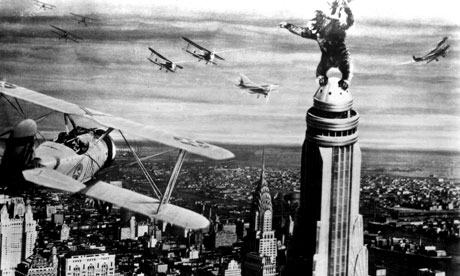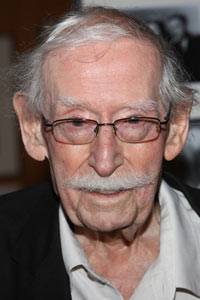
Redmond and his father integrated animatronics with live-action sequences on King Kong (1933).
In the history of cinema, many children have followed their mothers or fathers into the film business, but few offspring pursued the path of a parent more slavishly than Harry Redmond Jr, who has died aged 101. Like a master craftsman, Harry Redmond Sr passed on the skills of his trade to his son, the trade being the creation of special effects for films. Most notably, they worked together on King Kong (1933), in which a giant gorilla captures an actor, Ann Darrow, played by the "scream queen" Fay Wray.
The Redmonds were important members of the King Kong technical team under the supervision of Willis O'Brien, the pioneer of model animation. Part of their job was to integrate the stop-motion models and animatronics into live-action sequences by means of back projection and travelling mattes. Although the model of the giant ape was only 18 inches high, Kong appeared to be about 24ft tall, looming especially large among the New York skyscrapers.
"Special effects" have existed in cinema since the Lumière brothers' The Demolition of a Wall (1895), although they were not named as such. The term dates from 1926, the year that Redmond Sr and his family moved from New York, where he ran Metropolitan Studios, to California to take up an invitation to join Warner Bros to work on the Douglas Fairbanks extravaganza Don Juan, the first feature to have sound effects and a full musical score. At the same time, 17-year-old Redmond Jr started in films, in the prop department at the new First National Pictures studio in Burbank, where his father was working.
Four years later, the younger Redmond had learned enough to work on special effects alongside his father on Allan Dwan's Changes (1931), a first world war drama starring Douglas Fairbanks Jr. Much of the film's challenge lay in the flying sequences, which were later superseded by those in Howard Hawks's Only Angels Have Wings (1939), to which the Redmonds contributed greatly.
 Redmond's final credit was on the superior sci-fi series The Outer Limits.
Redmond's final credit was on the superior sci-fi series The Outer Limits.
The Redmonds were important members of the King Kong technical team under the supervision of Willis O'Brien, the pioneer of model animation. Part of their job was to integrate the stop-motion models and animatronics into live-action sequences by means of back projection and travelling mattes. Although the model of the giant ape was only 18 inches high, Kong appeared to be about 24ft tall, looming especially large among the New York skyscrapers.
"Special effects" have existed in cinema since the Lumière brothers' The Demolition of a Wall (1895), although they were not named as such. The term dates from 1926, the year that Redmond Sr and his family moved from New York, where he ran Metropolitan Studios, to California to take up an invitation to join Warner Bros to work on the Douglas Fairbanks extravaganza Don Juan, the first feature to have sound effects and a full musical score. At the same time, 17-year-old Redmond Jr started in films, in the prop department at the new First National Pictures studio in Burbank, where his father was working.
Four years later, the younger Redmond had learned enough to work on special effects alongside his father on Allan Dwan's Changes (1931), a first world war drama starring Douglas Fairbanks Jr. Much of the film's challenge lay in the flying sequences, which were later superseded by those in Howard Hawks's Only Angels Have Wings (1939), to which the Redmonds contributed greatly.
 Redmond's final credit was on the superior sci-fi series The Outer Limits.
Redmond's final credit was on the superior sci-fi series The Outer Limits. They also helped create the extraordinary aerial sequences in the first Fred Astaire-Ginger Rogers musical, Flying Down to Rio (1933), that featured about a dozen chorus girls dancing on the wings of a fleet of aeroplanes above Rio. At one stage, a girl falls off a wing but is caught on the wings of a plane swooping below. The film was made for RKO, the studio the Redmonds joined in 1932, where they brought their expertise to bear on some of their most memorable movies, above all King Kong, directed by Ernest B Schoedsack.
The Redmonds worked for the same director on The Son of Kong (1933), with a cute 24ft albino ape in the title role, and The Last Days of Pompeii (1935), for which they provided an impressive eruption of Mount Vesuvius. But by the mid-30s, Redmond Jr had already begun to carve out a career on his own as a freelance for various studios.
Among his first solo efforts were Frank Capra's Lost Horizon (1937), with its preliminary plane crash and the walk of the survivors across the snow-covered Himalayas towards Shangri-La. In the same year, while working on The Prisoner of Zenda (1937), for David O Selznick, Redmond met Dorothea Holt, who had just been made head of the art department of the same producer. They were married in 1940, and later worked together on three films. For one of these, The Bishop's Wife (1947), Redmond supplied Cary Grant, who plays an angel, with supernatural powers, able to get a typewriter to write a letter without being touched, a Christmas tree to be decorated in a trice, and a wine bottle to keep filling miraculously.
In The Stranger (1946), for Orson Welles, Redmond was technically responsible for the thrilling denouement played out in the clock tower when the villain (Welles) is impaled on the blade carried by a rotating figure. He also realised the opening sight gag in the Marx Brothers' A Night in Casablanca (1946) when Harpo, leaning against a wall, is asked by a policeman, "What do you think you're doing, holding up the building?" Harpo nods vigorously and then, as he walks away, the whole structure collapses.
In 1952, with Storm Over Tibet, into which footage from Lost Horizon was incorporated, Redmond began a long and fruitful working relationship with the Hungarian-born producer Ivan Tors. Like many sci-fi movies of the 50s, the two produced by Tors on which Redmond did the special effects were pervaded by cold war concerns, but that didn't spoil the mechanical fun. The Magnetic Monster (1953) tells of a new and highly dangerous radioactive element that draws energy from its surroundings, doubles its size regularly, and could throw the earth out of orbit, while the title role of Gog (1954) is played by a huge robot who is controlled by a thinking machine in a vast lab beneath the New Mexican desert.
Soon after, Tors and Redmond moved into television, with Science Fiction Theatre (1955-57) and Sea Hunt (1958-60), the latter distinguished by the extra-special underwater effects. The pair also co-produced Flipper (1963) and Daktari (1966). Redmond's final credit, before retiring from show business, was on the superior sci-fi series The Outer Limits (1963-64), which began with the warning: "There is nothing wrong with your television set. Do not attempt to adjust the picture. We are controlling transmission."
Redmond, whose wife died in 2009, is survived by a son, Lee, and a daughter, Lynne.
• Harry Redmond Jr, special effects creator, born 15 October 1909; died 23 May 2011
The Redmonds worked for the same director on The Son of Kong (1933), with a cute 24ft albino ape in the title role, and The Last Days of Pompeii (1935), for which they provided an impressive eruption of Mount Vesuvius. But by the mid-30s, Redmond Jr had already begun to carve out a career on his own as a freelance for various studios.
Among his first solo efforts were Frank Capra's Lost Horizon (1937), with its preliminary plane crash and the walk of the survivors across the snow-covered Himalayas towards Shangri-La. In the same year, while working on The Prisoner of Zenda (1937), for David O Selznick, Redmond met Dorothea Holt, who had just been made head of the art department of the same producer. They were married in 1940, and later worked together on three films. For one of these, The Bishop's Wife (1947), Redmond supplied Cary Grant, who plays an angel, with supernatural powers, able to get a typewriter to write a letter without being touched, a Christmas tree to be decorated in a trice, and a wine bottle to keep filling miraculously.
In The Stranger (1946), for Orson Welles, Redmond was technically responsible for the thrilling denouement played out in the clock tower when the villain (Welles) is impaled on the blade carried by a rotating figure. He also realised the opening sight gag in the Marx Brothers' A Night in Casablanca (1946) when Harpo, leaning against a wall, is asked by a policeman, "What do you think you're doing, holding up the building?" Harpo nods vigorously and then, as he walks away, the whole structure collapses.
In 1952, with Storm Over Tibet, into which footage from Lost Horizon was incorporated, Redmond began a long and fruitful working relationship with the Hungarian-born producer Ivan Tors. Like many sci-fi movies of the 50s, the two produced by Tors on which Redmond did the special effects were pervaded by cold war concerns, but that didn't spoil the mechanical fun. The Magnetic Monster (1953) tells of a new and highly dangerous radioactive element that draws energy from its surroundings, doubles its size regularly, and could throw the earth out of orbit, while the title role of Gog (1954) is played by a huge robot who is controlled by a thinking machine in a vast lab beneath the New Mexican desert.
Soon after, Tors and Redmond moved into television, with Science Fiction Theatre (1955-57) and Sea Hunt (1958-60), the latter distinguished by the extra-special underwater effects. The pair also co-produced Flipper (1963) and Daktari (1966). Redmond's final credit, before retiring from show business, was on the superior sci-fi series The Outer Limits (1963-64), which began with the warning: "There is nothing wrong with your television set. Do not attempt to adjust the picture. We are controlling transmission."
Redmond, whose wife died in 2009, is survived by a son, Lee, and a daughter, Lynne.
• Harry Redmond Jr, special effects creator, born 15 October 1909; died 23 May 2011
No comments:
Post a Comment